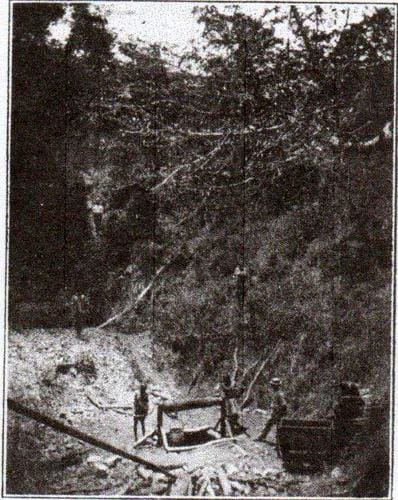The Primrose Mine.
The Primrose Mine was probably named after the Primrose League founded in 1883.

The Primrose Mine, nearly a mile north of the Phoenix Shaft just outside Que Que, was probably named after the Primrose League founded in 1883. The claims were pegged in 1894 by Mr. Fisk who probably was a member of the League, which promoted Conservative principles. (The founders included Randolph Churchill, who subsequently toured southern Africa and was very scathing about prospects in Rhodesia.) When the famous British Prime Minister, Benjamin Disraeli, died in 1881, Queen Victoria sent a wreath of primroses, his favorite flower.
The Primrose claims were acquired by the Chicago-Gaika Development Company. in 1898. Work did not begin until 1910. The claims were tributed to Hal Wiggins and R.K. Fletcher in 1938 who operated it until 1970, during which time it underwent several resurrections. In 1963 the claims were transferred to Lonrho and then a year later to Coronation Syndicate and then again in 1965 to Corsyn Consolidated (a subsidiary of Lonrho) which allowed Hal to keep digging.
The Heroic Life of a Trammer (A Wheelbarrow Boy.)
One entered the mine via an incline shaft and descended using a skip (gollivan or cocopan) with 4 wheels running on rail tracks. The gradient hadn’t been too well designed or worked out so it was a bit like riding a hurdy-gurdy switchback–equivalent to the Big Dipper at a fun park but not as comfortable! One person sat in the bottom while Hal stood above, balancing his feet on the bridle of the skip and holding onto the steel rope.
Hal named one place, where he had lost the reef, and had to probe in every direction, Piccadilly Circus.
The underground workings were poorly lit. There were no electric lights. Visitors were very privileged to be given a proper miner’s lamp attached to the hard hat. One had to crouch along the twisting and turning tunnels.
The size of the tunnel was determined by the jackhammer operators who drilled the holes for the dynamite. Bonuses were paid on the number of feet the ‘face’ was advanced each month, so the smaller the opening, the greater was the advance and the higher the bonus. Walking along these tunnels, even with a good light, required careful negotiations as draw points or ore boxes loomed up out of nowhere. The jackhammer operators, lashers & trammers only had the use of carbide lamps – a small flickering flame reflected by a shiny back plate.
The ore, once blasted, was moved by the trammer, from the working face along the winding tunnel to the shaft. He pushed a heavily laden wheelbarrow, using a carbide lamp perched on top of the pile of ore. He had to hunch over to prevent banging his head against the roof, or hitting his face against a plank hanging down from a draw point.
At the end of each trip, as he reached the shaft station, he would place a small stone in a shallow hole–these were his counters. Absolutely no one else touched his counters.
This was his task or ‘gwaza’ for the day, repeated 30 or so times during his shift. Then he'd ‘walk out’, by climbing the ladders installed at the side of the rail track in the inclined shaft which could take at least 30 minutes. (The sudden drop of temperature and humidity was often the cause of pneumonia, which was often fatal.
The mine yielded 0.46 oz of gold/ton in its first year of operation, never equaled or exceeded over its 70 years in operation. Altogether it yielded 65,362 ounces of gold including reworking the sands and slimes dams (worth about $130 m at todays price.)
The historical novel Whitewashed Jacarandas and its sequel Full of Possibilities are both available on Amazon as paperbacks and eBooks.
These books are inspired by Diana's family's experience in small town Southern Rhodesia after WWII.
The various characters lay bare the racial arrogance of the times, paternalistic idealism, Zionist fervor and anti-Semitism, the proper place of a wife, modernization versus hard-won ways of doing things, and treatment of endemic disease versus investment in public health. It's a roller coaster read.
References:
- Frank Tennick, who remembers the Primrose Mine.
- Zimbabwe Geological Survey Bulletin No. 67 Part II. The Economic Geology of the Country around Kwekwe by A. Du Toit. Harare, 1998.
- Photo credit: Rhodesian Miner's Handbook by John Milne, 1894.

